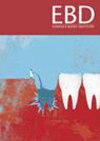Can AI find the cavities in caries prediction and diagnosis?
IF 2.3
Q3 Dentistry
引用次数: 0
Abstract
Rokhshad R, Banakar M, Shobeiri, P, Zhang P. Artificial intelligence in early childhood caries detection and prediction: a systematic review and meta-analysis. Pediatr Dent. 2024;46:385–394. A literature search was performed in May 2024 via PubMed, Scopus, Embase, Web of Science, Institute of Electrical and Electronics Engineer database sources, and across the grey literature. Further studies were identified after analysis of reference lists. The research question was defined using the population-intervention-comparison-outcome (PICO) framework. Studies published between 2010 and 2024 were included, that used artificial intelligence (AI) algorithms including machine learning (ML), deep learning (DL) and neutral networks (NN) for detecting and predicting early childhood caries (ECC). Exclusion occurred where the full text was inaccessible and non-English papers. Two independent reviewers screened titles and abstracts, with the use of a third reviewer in the case of any disagreement. The process was then repeated with the full texts to assess eligibility, again with a third reviewer where necessary. A total of 21 studies were used in the final analysis following assessment, 7 of which described ECC detection, and 14 for ECC prediction. The extracted data included author, publication year, study objectives, data modalities, datasets, annotation procedures, follow ups, ML test, AI model architecture, outcome measures and evaluation metrics. The findings were summarised descriptively. Quantitative synthesis was performed on six studies that reported sensitivity and specificity. Summary receiver operator characteristic curves were used to assess discriminatory ability. Statistical analysis was completed. A total of 21 studies were included in the final analysis. It revealed that AI based methods, especially DL algorithms showed promising results in detecting ECC, with accuracy range of 78–86%, sensitivity of 67–96%, and specificity from 81–99%. ECC prediction had accuracy range of 60-100%, sensitivity of 20–100%, and specificity of 54–94%. The pooled sensitivity and specificity of these studies was 80% and 81% respectively, with confidence intervals of 95%, indicating statistically significant effects. AI has demonstrated substantial potential in the detection and prediction of ECC. Further research is required to refine the technology and establish its application in paediatric dentistry.人工智能能否在龋齿预测和诊断中发现蛀牙?
Rokhshad R, Banakar M, Shobeiri, P, Zhang P.人工智能在儿童早期龋齿检测和预测中的应用综述。儿科杂志。2024;46:385-394。数据来源:文献检索于2024年5月通过PubMed, Scopus, Embase, Web of Science, Institute of Electrical and Electronics Engineer数据库资源和灰色文献进行。在对参考文献进行分析后,确定了进一步的研究。研究问题采用人口-干预-比较-结果(PICO)框架定义。研究选择:纳入了2010年至2024年间发表的研究,这些研究使用人工智能(AI)算法,包括机器学习(ML)、深度学习(DL)和神经网络(NN)来检测和预测儿童早期龋齿(ECC)。排除发生在全文无法访问和非英文论文。两名独立审稿人筛选标题和摘要,如果有任何分歧,则使用第三名审稿人。然后对全文重复该过程以评估合格性,必要时再次由第三方审稿人进行审查。评估后的最终分析共有21项研究,其中7项研究描述了ECC检测,14项研究描述了ECC预测。数据提取和综合:提取的数据包括作者、出版年份、研究目标、数据模式、数据集、注释过程、随访、ML测试、AI模型架构、结果测量和评估指标。对调查结果进行了描述性总结。对六项报告敏感性和特异性的研究进行了定量综合。摘要接收者操作者特征曲线用于评估鉴别能力。完成统计分析。结果:最终分析共纳入21项研究。结果表明,基于AI的方法,特别是DL算法在检测ECC方面显示出良好的效果,准确率范围为78-86%,灵敏度为67-96%,特异性为81-99%。ECC预测准确率为60-100%,灵敏度为20-100%,特异性为54-94%。这些研究的合并敏感性和特异性分别为80%和81%,置信区间为95%,表明有统计学意义。结论:人工智能在ECC的检测和预测方面显示出巨大的潜力。需要进一步的研究来完善该技术并确定其在儿科牙科中的应用。
本文章由计算机程序翻译,如有差异,请以英文原文为准。
求助全文
约1分钟内获得全文
求助全文
来源期刊

Evidence-based dentistry
Dentistry-Dentistry (all)
CiteScore
2.50
自引率
0.00%
发文量
77
期刊介绍:
Evidence-Based Dentistry delivers the best available evidence on the latest developments in oral health. We evaluate the evidence and provide guidance concerning the value of the author''s conclusions. We keep dentistry up to date with new approaches, exploring a wide range of the latest developments through an accessible expert commentary. Original papers and relevant publications are condensed into digestible summaries, drawing attention to the current methods and findings. We are a central resource for the most cutting edge and relevant issues concerning the evidence-based approach in dentistry today. Evidence-Based Dentistry is published by Springer Nature on behalf of the British Dental Association.
 求助内容:
求助内容: 应助结果提醒方式:
应助结果提醒方式:


